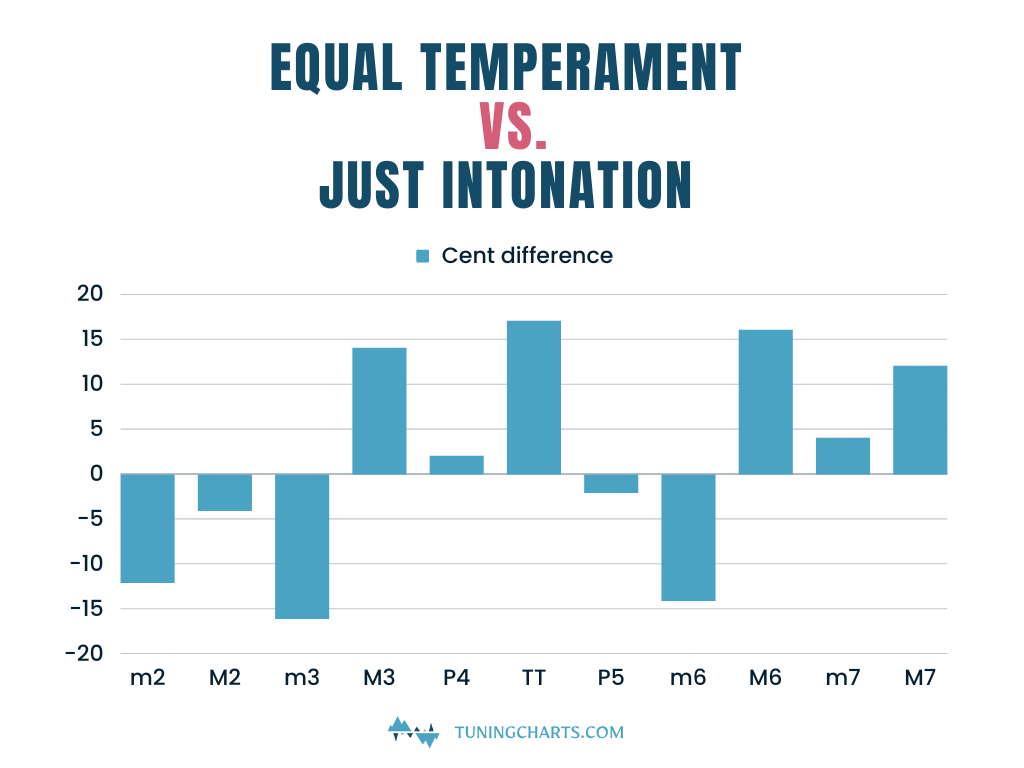10 Best Ways to Master Your Saxophone Intonation
Master the art of saxophone intonation with expert tips! Discover how to tune an alto sax like a pro.
Learn to Identify Pure Intervals
Just intonation offers a sense of clarity that stems from the harmonically perfect intervals it employs. The harmonies are rich, vibrant, and free from any dissonance. On the other hand, equal temperament sacrifices some of this clarity in favor of versatility and ease of modulation. While it may not provide the same level of harmonic perfection, it allows for a seamless transition between different keys. Since saxophones are tuned to equal temperament, it is important to know which interval you are currently playing and how to intonate them correctly. Our chart shows you how many cents you have to change to have the purest intervals.

Practice with Drone Tones
After identifying the intervals, the best way to practice them is with drone tones. While constantly aiming for the pure intervals, you will develop your hearing, muscle memory, and flexibility at the same time. Let’s start with something easy, like a major scale. Set the ground tone as a drone and try to match the desired pitches. If you are not sure if you found the right one, it’s also a great idea to use a tuner at this point (but make sure the reference note is clear).
Focus on the Thirds
Playing every note perfectly in tune is almost impossible. However, correcting the most out-of-tune notes will make a big difference. The most consonant and most out-of-tune intervals are the Major 3rds. Search for them in your score and try to correct them first!
Analyze the Pitch Tendencies of your Instrument
Tuning Chart‘s AI tuner helps analyze the pitch tendencies of your instrument and compare the intonation of different necks, mouthpieces and reeds in just seconds. You can achieve a much better overall intonation with proper testing and understanding your own setup. Aim for as low cent deviation as possible.

Choose the Right Equipment
Mouthpiece selection: The choice of mouthpiece plays a crucial role in saxophone intonation.
Considering factors such as chamber size, facing length, baffle design, and reed compatibility empowers you to find a mouthpiece that enhances intonation while aligning with your tonal concept and playing style.
Seek guidance from a knowledgeable saxophonist or instructor who can provide insights and recommendations based on your playing style and intonation goals.
Try mouthpieces from various manufacturers to explore different designs, materials, and craftsmanship.
Take advantage of trial programs offered by music stores or mouthpiece manufacturers to test multiple mouthpieces before making a final decision.
Record and analyze your playing to assess intonation accuracy with different mouthpieces and reed combinations.
Be patient and allow yourself time to adapt to a new mouthpiece. It may take some time to adjust and unlock its full potential.
Reed Considerations: When it comes to playing the saxophone, the importance of reeds cannot be overstated.
Reeds not only affect the sound quality and response of the instrument but also play a crucial role in intonation.
Different strengths of reeds require varying amounts of air pressure and embouchure control to produce the desired pitch and tone.
Using a reed that is too soft can result in a flat sound but allows more control, while a reed that is too hard can lead to sharpness.
Experimenting with different reed strengths allows you to find the optimal balance for achieving accurate intonation and comfortable playability.
There are various cuts available, including French, American, and V-shaped cuts, each offering distinct tonal characteristics and response.
The choice of reed cut can also significantly impact intonation.
Remember that finding the ideal reed setup is a process that requires experimentation and personal exploration.
Learn Alternate Fingerings
Alternate fingerings are not only important for certain transitions where the standard fingerings may be problematic. These can help address intonation issues by providing fingerings that produce lower or higher pitches. If you already know the pitch tendencies of your specific setup, use alternate fingerings to correct the out-of-tune notes.
Is it Better to Be on the Sharp Side?
Not only bringing the pitch down is always easier, human ear is also more tolerant for hearing slightly sharper pitches. Better to stay on the sharper side!
Ensemble Playing
Playing in a group or ensemble requires continuous listening and intonation, which can't be practiced alone. You need to develop the ability to play in tune with other musicians as well. Whether it's a jazz combo, concert band, chamber ensemble, or a backing track, go for it!
Warm-up your Instrument
There are many external factors that can change the pitch of wind instruments, such as temperature, humidity, and air content. The biggest factor is the temperature of the air. As the instrument gets warmer, the pitch raises. By warming up the instrument before tuning, we can make sure that the different parts of the saxophone will have an even temperature, resulting in a much more stable pitch.
Focus on the Sound Quality and Timbre
The overall timbre plays a huge role in the perception of pitch. A brighter, more overtone-rich sound will be perceived as much higher compared to a darker sound. If you find it difficult to match the pitch to another instrument, try to bring the timbre closer. To develop an even tone throughout different registers, don't skip your warm-up exercises.
+1 Bonus Tip
Don‘t Forget the Swab in Your Sax! 
Do you like this article?
Thanks for your feedback

World’s #1
Reed Recommendation System
We believe every musician deserves a reed that matches their unique style and sound. Each reed is selected with cutting-edge AI and machine learning based on your playing feedback.

